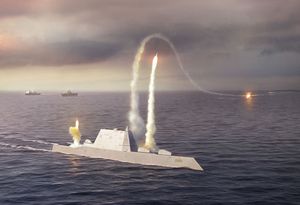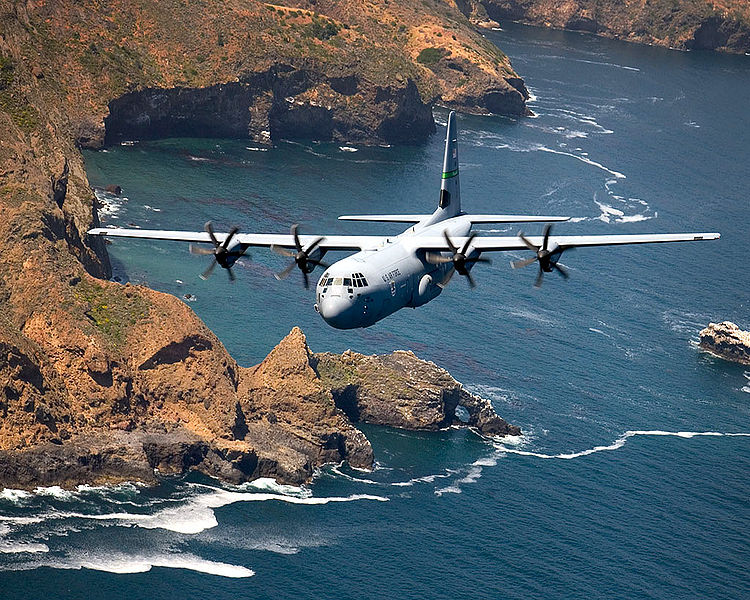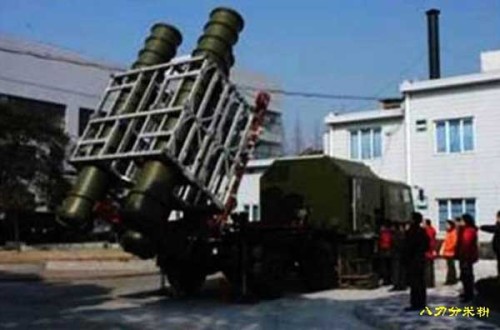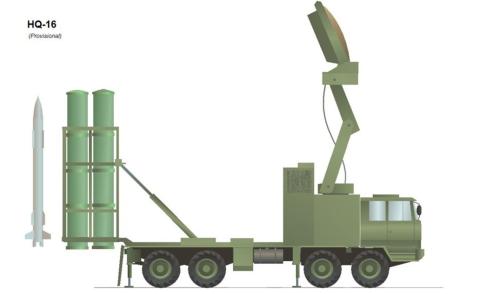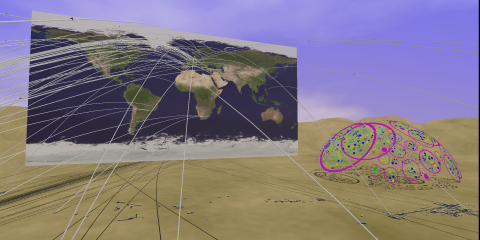25.08.2011 par Stéphane Dossé et Guillaume Tissier -Billets d’AGS sur le Cyber
La compétition stratégique entre la Chine et les Etats-Unis semble, de plus en plus s’étendre au cyberespace. Stéphane Dossé, Lignes stratégiques, et Guillaume Tissier, Directeur du pôle risques opérationnels de CEIS, nous livrent une réflexion personnelle sur le climat de guerre froide qui semble souffler sur le cyberespace, notamment à la suite de la parution, à l’été, de stratégies américaines dans le cyberespace.
Le 6 août 2011, la Chine par l’intermédiaire de son agence de presse officielle Xinhua[1], condamnait « l’addiction aux dettes » et les « querelles politiques [de Washington] qui manquent de vision à long terme ». Le communiqué ajoutait en réaction à la dégradation de la note de la dette américaine par Standard & Poor’s (S&P), le 5 août au soir, « La Chine a désormais parfaitement le droit d’exiger des Etats-Unis le réglement de leurs problèmes de dette structurelle et d’assurer la sécurité des actifs en dollars de la Chine ». Cette réaction, qui pourrait être considérée comme un acte d’ingérence dans les affaires intérieures des Etats-Unis, traduit un climat conflictuel entre les deux superpuissances et une montée progressive et tangible des tensions entre ces deux Etats, superpuissances à l’échelle mondiale. Les stratégies américaines de 2011 dans le cyberespace, notamment l’U.S. International strategy for cyberspace et la DoD strategy for operating in Cyberspace, apparaissent ainsi comme le vecteur et le symptôme d’une nouvelle guerre froide
.
Un contexte stratégique tendu
Les deux véritables superpuissances du XXIème siècle sont la Chine et les Etats-Unis, en raison de leurs poids politiques et économiques mais aussi militaires. Leurs relations plus ou moins tendues se caractérisaient par une coopération, principalement économique, et une compétition politique de plus en plus visible.
Lors de la crise financière de l’été 2011, la Chine a montré un visage plus agressif vis-à-vis des Etats-Unis qui fait quelque peu écho à quelques démonstrations de puissances dans les premières années du siècle, légitimes pour une puissance qui vient d’émerger.
Depuis la rétrocession d’Hong-Kong (1997) et de Macao (1999), la Chine, régime autoritaire à parti unique, membre permanent du Conseil de sécurité des Nations unies et seconde économie mondiale, entend montrer le renouveau de sa puissance au monde :
- entrée à l’Organisation mondiale du commerce en 2001 malgré un cours du Yuan manifestement et durablement sous-évalué qui peut s’interpréter comme une concurrence déloyale ;
- vols spatiaux habités depuis 2003, tir d’une arme antisatellite en 2007, station spatiale de recherche à partir de 2011, programme lunaire pour 2020, etc. ;
- jeux olympiques de Pékin en 2008 ;
- défilé militaire du 60ème anniversaire de l’armée populaire de libération (APL) en 2009 (100 000 participants, 8 000 véhicules et 150 aéronefs) ;
- exposition universelle de Shanghai en 2010.
- réduction en 2010 de ses quotas d’exportation de terres rares indispensables pour certaines technologies de pointe, dont elle produit 97% de la consommation mondiale, etc.
Au niveau économique, selon l’économiste Antoine Brunet, l’Etat chinois disposait fin juin 2011 d’un montant de réserves de change supérieur à 4 600 milliards de dollars, si l’on ajoute aux réserves de la Banque populaire de Chine, celles détenues par ses épigones, l’Autorité monétaire de Hong-Kong et les Fonds souverains de la Chine et de Hong-Kong. Cela représente environ deux années de budget fédéral américain, un tiers de la dette fédérale américaine. Un bon moyen de pression politique. La cession du centre de container du port du Pirée, par l’Etat grec au groupe chinois Cosco Pacific Ltd, pourrait apparaître comme l’implantation d’un comptoir au sein de l’Union européenne, tels que l’on pouvait les voir dans la Chine déclinante du début du XIXème siècle.
Au niveau militaire, l’APL poursuit sa modernisation en augmentant la qualité de son personnel, en menant une politique de mise en service de matériels majeurs comme un porte-avions, officiellement dans un but de recherche scientifique et d’entraînement[2], ou de numérisation des forces. Le 11 janvier 2011, la Chine aurait fait décoller pour la première fois son chasseur furtif J-20, lors d’une visite de Robert Gates, alors secrétaire américain à la défense. Elle développe également une politique de coopération militaire internationale jusque là inédite par son ampleur. Cette dernière est fondée sur les visites de hauts niveau à l’étranger, la participation à des exercices multinationaux, la promotion de l’image de la Chine dans les milieux de défense et la privation aux opérations de maintien de la paix, comme la FINUL (Liban) et de sécurisation des routes maritimes dans le golfe d’Aden et l’Océan indien, etc. Le budget chinois aurait augmenté de 7,5% en 2010 à 79 milliards de dollars. En augmentation depuis plus de 20 ans, son accroissement annuel moyen dans les années 2000 serait de 11,8% pour une croissance annuelle moyenne de 9,6% du PIB. Néanmoins, les Etats-Unis estiment le budget militaire chinois à plus de 150 milliards de dollars, en raison de l’opacité des finances publiques.
Cette montée en puissance de la Chine n’est pas sans causer d’inquiétudes aux Etats-Unis, par l’intermédiaire du DoD, qui font paraître annuellement un rapport de synthèse, à destination du Congrès, sur la puissance militaire chinoise : le Military Power of the People’s Republic of China, de 2002 à 2009, puis le Military and Security Developments Involving the People’s Republic of China en 2010 et en 2011. La Chine est le seul pays, en dehors de ceux dans lesquels les Américains sont en guerre, à bénéficier d’une telle attention publique. Cela rappelle le Soviet military power de la guerre froide. Dans le rapport de 2010, la doctrine américaine vis-à-vis de la Chine est clairement affichée, sous les mots du président Obama : « [la relation Etats-Unis - Chine] n’a pas été sans désagrément ni difficultés. Mais le concept selon lequel nous devons être adversaire n’est pas inéluctable ». Les Etats-Unis coopèrent avec la Chine, tout en « surveillant » sa puissance militaire et en la dissuadant d’un conflit, notamment dans le cadre d’une action contre Taïwan. Le 29 juin 2011, un avion espion U2 américain[3] aurait été raccompagné par la chasse chinoise vers les eaux internationales en mer de Chine du sud. Le 25 juillet 2011, deux avions Su-27 chinois ont violé l’espace aérien de Taïwan, ce qui n’était pas arrivé depuis 1999, pour intercepter un U2 américain. Le soutien de Pékin au régime totalitaire de Pyongyang reste d’autant plus un sujet de préoccupation que la Corée du nord provoquerait des incidents avec son voisin du sud, parfois très graves comme lors du torpillage du navire sud-coréen Cheonan (46 morts) le 26 mars 2010 et du bombardement de l’île de Yeonpyeong, le 23 novembre 2010.
C’est dans ce contexte de tension qu’il est possible de qualifier de guerre froide que les Etats-Unis et la Chine adoptent progressivement une position conflictuelle dans le cyberespace.
La puissance chinoise dans le cyberspace
Les deux grandes puissances prennent en effet leurs marques dans un cyberespace en plein bouleversement : le nombre d’internautes a explosé (1,7 milliard), mais surtout le centre de gravité d’internet a changé avec la montée en puissance des pays émergents et de la Chine qui compte à elle seule 420 millions d’internautes (dont 277 millions se connectent par téléphone) contre 220 millions aux Etats-Unis. C’est en fait une sorte d’internet parallèle qui se développe en Chine. Le pays dispose maintenant de sa propre architecture DNS avec des noms de domaine constitués d’une série de chiffres, ce qui permet au réseau de fonctionner de manière autonome. L’ICANN a également approuvé en 2010 les TLD (ou domaines de premier niveau) en caractères chinois. Le marché chinois des télécommunications et systèmes d’information est quant à lui en pleine expansion malgré une décennie de retard sur les pays les plus développés numériquement et des disparités régionales très fortes en termes de taux de pénétration internet.
Le point noir reste évidemment la censure systématique dont internet fait l’objet dans le pays. Comme le soulignait, en 2011, Mme Hillary Clinton, secrétaire d’Etat américaine, la Chine est le seul pays non démocratique qui parvient à se développer avec un contrôle strict d’Internet par l’Etat. Cette politique de censure répond en réalité à la fois à des préoccupations politiques et économiques. Cela permet aux sites chinois de se développer à l’abri de la concurrence occidentale à l’image de Baidu, le Google chinois, ou de Renren, le Facebook local qui compte déjà 120 millions d’utilisateurs[4]. De la production de composants à la fourniture de services, le secteur des télécommunications et de l’informatique prospère également, favorisé par une politique volontariste de formation, de soutien à la R&D et de normalisation.
Sur le terrain, la Chine mobiliserait 30 000 à 40 000 agents pour sa police de l’Internet pouvant être épaulés par plusieurs centaines de milliers de Honkers, corsaires informatiques chinois, pouvant assurer le contrôle social du web, sur les forums et les réseaux sociaux. Ces derniers dont la dépendance vis-à-vis du régime reste floue (Red Hackers of China, China Eagle Union, Green Army Corps ou Honkers Union of China) n’ont pas hésité à s’attaquer à des sites à l’étranger, dans les années 2000. Le 8 août 2011, elle a annoncé le développement d’un Plan pour le développement des enfants chinois (2011-2012) qui vise à « assurer un environnement de l’Internet sain pour les enfants en fournissant un accès public gratuit ou à bas prix exclusivement pour les enfants et en mettant en place des logiciels spéciaux pour filtrer toute information nuisible » et à lutter contre les cybercafés illicites. Ceci complète différentes mesure antérieures comme le système de filtrage par mots-clés, mis en place durant les « révolutions arabes », début 2011.
Le paradoxe est que malgré son potentiel de censure et de contrôle et un durcissement récent des mesures de lutte anti-cybercriminalité, la Chine se plaint régulièrement de la cybercriminalité – souvent lorsqu’elle est désignée comme menace-, dont elle serait plus une cible qu’une source. Selon l’agence Xinhua, le 9 août 2011, la Chine aurait été victime de 500 000 cyberattaques en 2010, dont la moitié de l’étranger, en particulier d’Inde et des Etats-Unis, deux concurrents stratégiques. Si cette posture de victime sonne parfois faux, elle témoigne aussi d’une véritable évolution. La situation d’asymétrie dont jouissait le pays vis-à-vis des Etats-Unis au plan informatique est désormais révolue. Compte tenu de la taille de ses réseaux, le pays est désormais vulnérable et ne parvient même plus totalement à empêcher des internautes dissidents de contourner ses murailles numériques.
Pour faire face à la menace, la Chine développe sa capacité de lutte informatique, selon son livre blanc de 2010 car elle considère le cyberespace comme un enjeu stratégique. Elle se doterait d’un boulier cybernétique dans le cadre d’un programme baptisé « Kylin ». En juin 2011, l’APL a déclaré avoir constitué une équipe spécialisée dans le cyber et dispose déjà d’unités de systèmes d’information et de communication et de guerre électronique en grand nombre[5]. Si le pays ne semble pas disposer de doctrine de lutte informatique officielle, la lutte informatique s’intègre dans un concept de « guerre hors limite » en vertu duquel le cyberespace civil peut être utilisé dans une « guerre totale », déclinaison récente de la notion de « guerre du peuple » chère à Mao.
Ainsi, avec une composante symétrique d’action dans le cyberespace, via ses forces régulières, et une composante asymétrique, via les honkers, les Chinois disposent de capacités de cyberguerre significatives pouvant être mobilisées en cas de conflit armé ou non.
Une compétition accrue dans le cyberespace
Le premier affrontement entre la Chine est les Etats-Unis est d’abord idéologique. Les Etats-Unis défendent clairement le principe de liberté d’accès à Internet, comme liberté individuelle et collective et moyen de développement économique. Si dans les faits, les pratiques américaines de contrôle des flux numériques ne sont pas exempts de commentaires, il faut reconnaître que leur attachement au libre échange des idées est bien réel. Le rappel du premier amendement de la constitution américaine, « gravée dans 50 tonnes de marbre du Tennessee », par Mme Hillary Clinton, le 21 janvier 2010, lors d’un forum sur la liberté sur Internet au Newseum, n’est pas anodin. Dans son discours, réagissant à l’opération Aurora, la Chine apparaissait comme sa cible principale – non exclusive. Elle attaqua les pays ne respectant pas la liberté d’expression sur Internet et leur prédisait même une mise à l’écart de la marche du progrès au XXIème siècle. Plus gravement, l’asymétrie d’accès à l’information serait une cause de guerre interétatique…
« Mais les pays qui restreignent le libre accès à l’information ou violent les droits fondamentaux des utilisateurs d’Internet risquent de se murer, en se coupant du progrès pour le reste du siècle. Actuellement, les Etats-Unis et la Chine ont des vues différentes sur cette question, et nous avons l’intention de répondre à ces différences de manière franche et cohérente, dans le cadre de notre relation positive, coopérative et globale. [...] La liberté de l’information soutient la paix et la sécurité, fondements du progrès mondial. Historiquement, l’accès asymétrique à l’information est l’une des principales causes de conflits interétatiques. »
Le 15 février 2011, Mme Clinton reprenait ses critiques vis-à-vis de la censure sur l’Internet chinois et les réseaux d’autres pays cibles régulières des Etats-Unis : Cuba, Iran, et affirmait même qu’aucun développement économique n’était maintenant possible sans liberté sur Internet, à l’exception de la Chine. Une exception de taille, il faut en convenir.
Au-delà de la liberté d’opinion, les intérêts économiques des Etats-Unis dans le cyberespace sont majeurs. Il comprend environ 2 milliards d’internautes et presque 5 milliards d’abonnés à la téléphonie mobile. Internet représente 5 000 milliards de dollars de propriétés intellectuelles américaines dont 300 milliards sont volés annuellement[6]. Certains experts soupçonnent souvent la Chine, sans preuves formelles, d’être l’un des grands acteurs de ce pillage. Les opérations Aurora et Shady Rat[7], cyberattaques visant respectivement une trentaine et 72 entreprises, principalement américaines, sont attribuées à la Chine qui a démenti en être à l’origine. Par ailleurs, les entreprises chinoises dans le domaine de l’Internet se développent rapidement et constituent une concurrence parfois à l’échelle mondiale, si l’on pense à Huawei, deuxième fournisseur mondial de réseaux derrière Ericsson mais devant Cisco ou Alcatel-Lucent.
Les Etats-Unis se positionnent comme le leader du « Monde libre » dans le cyberespace, sous entendu « démocratique », pour reprendre les propos du discours de Fulton de Winston Churchill, le 5 mars 1946. Un nouveau rideau de fer aurait séparé le cyberespace, notamment la Chine des Etats-Unis et de leurs alliés. La cyberdétente appelée de leurs vœux par M. Henry Kissinger, ancien secrétaire d’Etat, et M. Jon Huntsman, ancien ambassadeur américain en Chine, en juin 2011, à l’occasion d’un événement organisé par Thomson Reuters, semble confirmer ce climat de guerre froide entre la Chine et les Etats-Unis.
C’est dans ce contexte général et particulier que les Etats-Unis ont publié en 2011 des stratégies qui montrent des similitudes certaines avec celles de la guerre froide, notamment l’initiative de défense stratégique.
Les stratégies d’une cyberguerre froide ?
Presque à chaque fois que les Etats-Unis se sentent menacés militairement ou sont attaqués, ils axent leurs stratégies majeures selon des axes économique, militaire et moral. En raison de leur histoire, ils se pensent comme d’abord comme une terre devant être sanctuarisée et devant être protégée à tout prix contre les menaces extérieures : missiles nucléaires intercontinentaux (dont sous-marins) pendant la Guerre froide, terrorisme jihadiste durant la guerre contre le terrorisme et cyberattaques. Pour cela, ils doivent mobiliser leur formidable outil économique, en assurant une synergie entre le public et le privé, entre le civil et le militaire, entre le citoyen et l’Etat. Ils doivent aussi mettre en ordre de bataille leurs capacités militaires, scientifiques, diplomatiques qui seront leurs moyens d’actions dans le champ des relations internationales.
Par ces politiques ambitieuses et volontaristes, non dénuées d’un risque scientifique et politique assumé, les Etats-Unis organisent la mobilisation du pays autour de projets fédérateurs :
- la course à la Lune contre les soviétiques pour environ 5 milliards de dollars annuels de l’époque (discours du président Kennedy de l’Université de Rice du 12 septembre 1962) ;
- la guerre des étoiles contre les soviétiques pour environ 5 milliards de dollars de R&D annuels (discours du président Reagan du 23 mars 1983) ;
- la guerre globale contre le terrorisme pour 130 milliards de dollars annuels (discours du président G.W. Bush du 20 septembre 2001 devant le congrès) ;
- la stratégie américaine internationale pour le cyberespace pour environ 5,5 milliards de dollars annuels de R&D.
Ainsi, le 16 mai 2011, le président Obama a présenté la publication de la stratégie américaine pour le cyberespace U.S. International strategy for cyberspace (ISC). Elle s’appuie principalement sur trois voies : la diplomatie, la défense et le développement économique. Elles concourent aux objectifs stratégiques : développer l’ouverture et l’interopérabilité du cyberespace, sécuriser et fiabiliser les réseaux et promouvoir la stabilité de l’Internet par l’intermédiaire de normes. Cette stratégie a ensuite été déclinée en stratégies particulières. La maison blanche a également présenté, le 25 juillet, une nouvelle stratégie, Strategy to Combat Transnational Organized Crime, pour combattre la cybercriminalité transnationale.
Le 14 juillet 2011, le Département d’Etat a publié les priorités de la cyberdiplomatie américaine qui se fixe les objectifs suivants :
- promouvoir l’innovation et l’ouverture des marchés ;
- améliorer la sécurité, la disponibilité et la résilience des réseaux mondiaux ;
- étendre la collaboration juridique et la législation internationale ;
- préparer les défis sécuritaires du 21° siècle ;
- promouvoir des structures efficaces de gouvernance de l’Internet ;
- développer des capacités cyber, la sécurité et la prospérité au travers du développement d’Internet ;
- soutenir les principes de liberté fondamentale et de vie privée.
Le même jour, le Department of Defense des Etats-Unis a publié la version non classifiée de sa stratégie pour le cyberespace : DoD strategy for operating in Cyberspace (DoD SOC). La DoD SOC définit le contexte stratégique et fixe 5 initiatives stratégiques à court et moyen termes :
- Tirer avantage du cyberspace ;
- Etablir de nouveaux concepts de protection des réseaux ;
- Mettre en place un partenariat interministériel, interagences et public-privé ;
- Construire un système de sécurité collective dans le cyberespace ;
- Développer les capacités technologiques et humaines pour opérer dans le cyberespace.
L’objectif de ces stratégies est clair : le « cyber power », lequel agit à la fois comme un multiplicateur de puissance « conventionnelle » mais constitue aussi un champ d’expression de la puissance à parts entières.
De la guerre des étoiles à la menace fantôme ?
Des similitudes importantes existent avec l’Initiative avec l’initiative de défense stratégique lancée le 23 mars 1983 par le président Reagan, et formalisée dans la Strategic defense initiative (SDI) du 6 janvier 1984. Si dans la SDI, l’Union soviétique était clairement visée, aucun adversaire n’est nommément mentionné dans les stratégies cyber ; la menace est cette fois étatique ou non. Néanmoins, au regard des thèmes abordés et des capacités chinoises étatiques et non étatiques dans le cyber, la Chine apparaît clairement comme l’un des adversaires principaux. Le cyberespace devient un vecteur de la confrontation stratégique avec la Chine, comme par exemple l’Espace l’avait été avec l’Union soviétique.
De manière générale, la SDI et la DoD SOC ont été présentées comme des politiques défensives, ayant pour but de mettre en échec une capacité offensive, respectivement nucléaire et cyber, pouvant porter gravement atteinte à la sécurité des Etats-Unis et de leurs alliés. La SDI voulait créer une capacité de dissuasion défensive active, tout comme la SOC veut renforcer la résilience et la défense active des réseaux. Elles partent toutes deux du postulat que les capacités des adversaires sont peu connues et qu’il est nécessaire de surveiller leurs activités.
L’initiative n°1 du DoD SOC vise à organiser l’action militaire des Etats-Unis dans le cyberespace. Une bonne partie de la National security decision 119 pour la SDI faisait brièvement de même dans son point 3 qui mena à la création de la SDI organization en avril 1984.
La SDI étant en soi un nouveau concept de défense contre les missiles soviétiques, notamment dans son point 4, qui devait s’intégrer dans des concepts stratégiques plus globaux préexistants par ailleurs (point 2). Cette recherche de la nouveauté est présente dans l’initiative n°2 qui a le but de développer des concepts novateurs de protection active et passive.
La mobilisation, dans une approche globale, du secteur public et du secteur privé pour le DoD SOC, dans l’initiative n°3, fait écho au point 1 de la SDI et surtout au discours du président Reagan qui avait appelé la communauté scientifique à se mobiliser.
L’initiative n°4 a pour but de renforcer la sécurité collective dans le cyberespace, autour d’alliés et de partenaires poursuivant les mêmes buts et adhérant aux mêmes valeurs que les Etats-Unis. Dans le cadre de la guerre froide, le système de défense collective existait déjà, en particulier par l’intermédiaire de l’Alliance atlantique. Néanmoins, le président Reagan a précisé dans son discours que son pays allait poursuivre ses engagements sécuritaires vis-à-vis de ses alliés. Ceci a été repris dans le point 6 de la directive SDI qui vise à évaluer les conséquences pour les Etats-Unis et leurs alliés du programme.
Finalement, il est nécessaire de constater que, parmi les principales difficultés scientifiques de la SDI, la mise en réseau des armes antimissiles et de l’alerte avancée était bien présente. La SDI était déjà partiellement un programme qui serait actuellement qualifié de cyber. Selon un sondage de la Peter Hart organization, seulement 17% des physiciens américains pensaient que le projet était réaliste en 1986[8]. En particulier, certains informaticiens en 1983 estimaient qu’il fallait plusieurs dizaines de millions de lignes de code pour soutenir le programme, ce qui était hors de portée des capacités américaines du moment. La fiabilité des codes était également en question. Des erreurs de programmation avaient en 1979 et en 1980 auraient même pu entraîner une riposte nucléaire américaine à la suite de fausses alarmes[9]. Néanmoins, en raison du computer gap depuis les années 50 entre l’URSS et les Etats-Unis (10 fois moins d’ordinateurs souvent obsolètes en URSS), une réussite dans le domaine informatique, « monstre de l’impérialisme et de la pseudoscience » pour les soviétiques des années 1950, pouvait donner un avantage stratégique décisif aux Américains[10]. La SDI permettait de distancer des soviétiques cherchant à relever le défi de la révolution de l’informatique personnelle (IBM PC en 1981, Macintosh en 1984 et scission d’ARPANET en MILNET et INTERNET en 1984), avec l’arrivée au pouvoir de Mikhail Gorbatchev en 1984 et la création de l’organisation Inter-robot[11].
En 1985, les progrès techniques dans les architectures réseaux permettaient de fractionner la gestion informatique du système en ensemble en éléments de moins de 10 000 lignes de codes, ce qui fut possible dans les années suivantes. Ceci a permis de développer la recherche permettant de distribuer le traitement informatique, principe de l’Internet actuel, dans les réseaux qui étaient à l’époque généralement centralisé[12]. Dans le cadre de l’initiative n°5 du DoD SOC, avec le développement de CORONET, réseau devant remplacer Internet en développant des technologies optiques, et du National cyber range, réplique du réseau Internet pour l’entraînement et l’expérimentation, les Etats-Unis semblent chercher à recréer artificiellement le computer gap avec la Chine. Les sommes consacrées à la R&D pour le cyber sont par ailleurs tout à fait comparables à celles de la SDI.
Tout comme la SDI, en son temps, les stratégies américaines pour le cyberespace, qui ne s’appliquent pas qu’aux menaces étatiques majeures mais également à la cybercriminalité quotidienne – c’est en cela qu’elles diffèrent franchement de la SDI, sont à considérer comme un catalyseur de la puissance et des compétences américaines, sous l’impulsion de l’Etat fédéral pour tenter d’annihiler une menace jugée insupportable.
Conclusion
Au-delà des affrontements « techniques » dont il est le théâtre, le cyberespace est, qu’on le veuille ou non, devenu un véritable enjeu de puissance. A l’Internet universel et homogène que l’on connaissait succède progressivement un cyberespace fragmenté, gouverné par une logique de blocs ou de zones d’influence. Faut-il pour autant y voir comme certains la fin de l’Internet ? Il s’agit plutôt de la fin « d’un » internet et d’une évolution naturelle, déjà à l’œuvre depuis plusieurs années, qui a vu le « politique » envahir cet espace et les Etats chercher à y exprimer, légitimement ou non, leur souveraineté.
Il était donc logique que la rivalité stratégique entre les Etats-Unis et la Chine gagne également ce territoire, voire se concentre à terme sur cet espace qui offre de nombreux avantages d’un point de vue stratégique. Le cyberespace favorise tout d’abord les affrontements clandestins et de basse intensité, ce qui permet en théorie d’éviter des conflits directs et ouverts. Il est ensuite transverse aux environnements physiques et constitue le « ciment » permettant de coordonner des capacités d’action dans ces différents milieux. Comme le souligne Joseph S. Nye, « le cyber power peut être utilisé pour créer des résultats au sein du cyberespace mais il peut aussi utiliser des instruments cyber pour produire des résultats dans d’autres domaines en dehors du cyberespace »[13]. Enfin, les technologies qu’il implique sont par essence duales et utilisables indistinctement dans le monde civil et militaire. C’est là l’un des axes clés de la nouvelle stratégie américaine dans le cyberespace : les Etats-Unis ont été à l’origine du développement d’Internet, ils doivent non seulement maintenir mais accentuer le fossé technologique avec leurs adversaires en imaginant et en construisant les réseaux de demain. Quitte, pour ce faire, à instrumentaliser quelque peu la menace.
[1] Dette américaine : « la Chine, en tant que créancier, doit rester vigilante », La Tribune, 8 août 2011 consulté le 9 août 2011.
[2] Geng Yansheng, porte-parole du ministère chinois de la défense, Pékin, 27 juillet 2011.
[3] En 2001, un avion de surveillance EP-3 américain avait été contraint de se poser d’urgence dans le sud de la Chine, après une collision avec un avion chinois venu l’intercepter en Mer de Chine. Collision entre deux avions chinois et américain, 1er avril 2001, Nouvel observateur, site consulté le 8 août 2011.
[4] La société a d’ailleurs été créée par un Chinois formé aux Etats-Unis et la société est depuis peu cotée à New York…
[5] L’APL pourrait détenir plus d’une centaine de bataillons de transmissions ou de guerre électronique selon le rapport de la RAND. The People’s Liberation Army as Organization, Dennis J Blasko, 2000. L’auteur fut officier de renseignement dans l’US Army, spécialisé dans les affaires chinoises.
[6] Statement of general Keith b. Alexander, commander United States Cyber Command before the House committee on armed services, 23 septembre 2010. www.defense.gov, consulté le 2 mai 2011. Garamone Jim, Cybercom Chief Details Cyberspace Defense, American forces press service, 23 septembre 2010.
[7] Noms donnés en 2010 et 2011 par Dmitri Alperovitch, Vice Président de McAfee chargé des menaces.
[8] MIGLAUTSCH Thomas, Little scientific defense for Star Wars, Milwaukee journal, 10 juillet 1986.
[9] HALLORAN Richard, Computer signals 2nd mistaken report of USSR nuclear attack, Youngstone Vindicator, 6 juin 1980. Ces incidents furent repris dans le film War games de 1983.
[10] FULTON Lewis, Soviet face computer lag, Lakeland Ledger, 10 décembre 1962. SHABAD Theodore, Soviet concedes a computer gap, The New York times, 4 mai 1971. Computer cargo to USSR seized, New York Times in The Milwaukee Journal, 21 novembre 1983.
[11] GEROL Ilya, Soviets are missing out on computer revolution, Ottawa citizen, 27 décembre 1985.
[12] MORRING Franck, Star wars defense plan run by computer called possible, The Deseret News, 25 décembre 1985.
[13]NYE Jospeh S. Jr, Cyber Power,Belfer Center for Science and International Affairs, Harvard Kennedy School,mai 2010. Source : http://web.mit.edu/ecir/pdf/nye-cyberpower.pdf.





